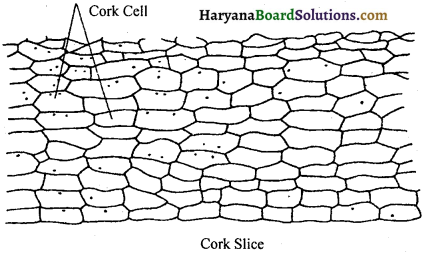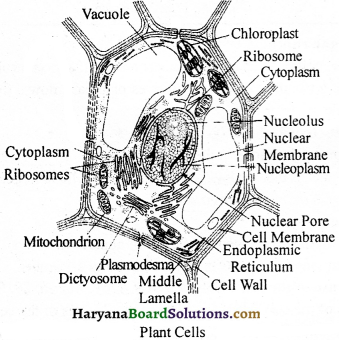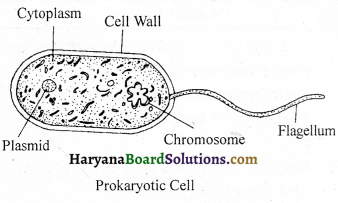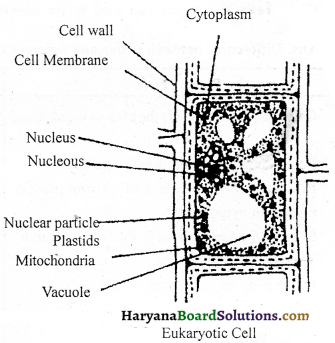Haryana State Board HBSE 9th Class Science Solutions Chapter 5 The Fundamental Unit of Life Textbook Exercise Questions and Answers.
Haryana Board 9th Class Science Solutions Chapter 5 The Fundamental Unit of Life
HBSE 9th Class Science The Fundamental Unit of Life Intext Questions and Answers
Questions from Sub-section 5.1
Question 1.
Who discovered cells, and how?
Answer:
Cells were first discovered by Robert Hooke in 1665. He observed the cells in a cork slice with the help of a primitive microscope.

Question 2.
Why is the cell called the structural and functional unit of life?
Answer:
All living organisms are made up of cells. A single cell may constitute a whole organism as in Amoeba, Paramoecium, Chlamydomonas, etc. These organisms are called unicellular organisms. On the other hand, many cells group together in a single body and form various body parts in multicellular organisms such as plants and animals. Each cell performs certain basic functions that are characteristic of all living forms. Due to these reasons, a cell is called the structural and functional unit of life.
All living organisms are made up of cells. A single cell may constitute a whole organism as in Amoeba, Paramoecium, Chlamydomonas, etc. These organisms are called unicellular organisms. On the other hand, many cells group together in a single body and form various body parts in multicellular organisms such as plants and animals. Each cell performs certain basic functions that are characteristic of all living forms. Due to these reasons, a cell is called the structural and functional unit of life.
![]()
Questions from Sub-section 5.2.1
Question 1.
How do substances like CO2 and water move in and out of the cell ? Discuss.
Answer:
CO2 and water can move across the cell membrane by a process called diffusion. We know that movement of substances is from a region of high concentration to a region where concentration is low. When the concentration is high in the cell due to the increasing in the quantity of CO2 and the concentration of outer environment is relatively low, just then due to a difference of concentration of CO2 inside and outside a cell, CO2 moves out of the cell from a region of high concentration to a region of low concentration outside the cell by the process of diffusion. Similarly, molecule of water moves from outside (high concentration) to inside (low concentration) by the process of osmosis.
Question 2.
Why is the plasma membrane called a selectively permeable membrane?
Answer:
Plasma membrane is made up of protein and lipid molecules. It acts as selectively permeable membrane:
1. ft allows the substances to enter, which are required by cell.
2. It does not allow the substances to enter, which are not required by cell.
3. It allow the substances to move out, which are not required by cell.
4. It does not allows the substances to move out, which are required by cell.
Due to above stated properties, plasma membrane is called selectively permeable membrane.
![]()
Questions from Sub-sections 5.2.2-5.2.4
Question 1.
Fill in the gaps in the following table illustrating differences between prokaryotic and eukaryotic cells.

Answer:
| Prokaryotic cell | Eukaryotic cell |
| I. Size: generally small. (1-10μm) 1μm = 10-6m | 1. Size: generally large. (5 – 100 μm) |
| 2. Nuclear region: not well defined and is not surrounded by a nuclear membrane and is known as nucleoid. | 2. Nuclear region: well defined and surrounded by a nuclear membrane. |
| 3. Chromosome: single. | 3. More than one chromosome. |
| 4. Membrane-bound cell organelles absent. | 4. Membrane-bound cell organelles present. |
Questions from Sub-section 5.2.5
Question 1.
Can you name the two organelles we have studied that contain their own genetic material ?
Answer:
(i) Nucleus
(ii) Mitochondria.
Question 2.
If the organization of a cell is destroyed due to some physical or chemical influence, what will happen ?
Answer:
The cell will not be able to perform its functions like respiration, protein synthesis, excretion, nutrition, etc.
![]()
Question 3.
Why are lysosomes known as suicide bags?
Answer:
Lysosomes may digest their own cell under certain conditions when the cell is damaged. Therefore lysosomes are known as suicide bags.
Question 4.
Where are proteins synthesized inside the cell?
Answer:
Proteins are synthesized in ribosomes attached on the surface of rough endoplasmic reticulum (RER).
HBSE 9th Class Science The Fundamental Unit of Life Textbook Questions and Answers
Question 1.
Make a comparison and write down ways in which plants cells are different from animal cells.
Answer:
Differences between Plants and are as follows:
Plant Cells:
1. Cell wall present outside the plasma membrane.
2. Centrosome and Golgilbodies are absent.
3. Plastids (chloroplasts and chromoplasts) present in cytoplasm.
4. Reserve food material is in the form of starch.
5. These have definite size.
6. It is usually larger in size.

Animal Cells:
1. Cell wall absent. Bounded by a thin living plasma membrane only.
2. Centrosomes and Golgibodies are present.
3. Plastids absent in cytoplasm.
4. Reserve food material is in the form of glycogen.
5. These have indefinite size.
6. It is comparatively smaller in size.

Question 2.
How is a prokaryotic cell different from a eukaryotic cell?
Answer:
Differences between prokaryotic cell and eukaryotic cell are as follows:
Prokaryotic Cell:
1. Size is generally small (1-10 um).
2. Nuclear material (nucleoid) is not enclosed in a nuclear membrane.
3. Have a single chromosome.
4. Nucleolus absent.
5. Membrane-bound organelles absent.
6. Cell division occurs by fission or budding (no mitosis).

Eukaryotic Cell:
1. Size generally large (5-100 um).
2. Nuclear material is enclosed in a nuclear membrane.
3. Have more than one chromosome.
4. Nucleolus present.
5. Membrane-bound organelles present.
6. Cell division mitotic or meiotic.

Question 3.
What would happen if the plasma membrane ruptures or breaks down?
Answer:
Plasma membrane separates the contents of the cell from its external environment. It also controls entry or exit of materials in and out of the cell. In case, a plasma membrane ruptures or breaks down, the above functions cannot be performed and the cell may die.
![]()
Question 4.
What w ould happen to the life of a cell if there was no Golgi apparatus?
Answer:
Golgi apparatus performs the following important functions in the cell:
(i) It packages materials synthesised in E.R. and dispatches them to intercellular and extracellular targets.
(ii) It helps in the formation of cell plate in plant cells during cell division.
(iii) It is involved in synthesis of lysosomes and peroxisomes.
(iv) In some cases, complex sugars may be made from simple sugars in the Golgi apparatus.
The life of a cell will be affected for the above-mentioned functions if there is no Golgi apparatus.
Question 5.
Which organelle is known as the powerhouse of the cell? Why?
Answer:
Mitochondria are known as the powerhouses of the cell. They are called powerhouses of the cell because the energy required for various chemical activities needed for life is released by mitochondria in the form of ATP (Adenosine triphosphate) molecules. ATP is known as the energy currency of the cell.
Question 6.
Where do the lipids and proteins constituting the cell membrane get synthesized?
Answer:
Rough endoplasmic reticulum (RER) has particles called ribosomes attached to its surface. The ribosomes are the sites of protein synthesis. The smooth endoplasmic reticulum (SER) helps in the synthesis of fat molecules, or lipids. Some of these proteins and lipids help in the building of cell membranes.
Question 7.
How does an Amoeba obtain its food?
Answer:
The flexibility of the cell membrane also enables the cell to engulf in food and other materials from its external environment. Such processes are known as endocytosis. Amoeba acquires its food through such processes.
![]()
Question 8.
What is osmosis?
Answer:
Osmosis is the passage of water from a region of high water concentration through a semi- permeable membrane to a region of low water concentration.
Question 9.
Carry out the following osmosis experiment:
Take four peeled potato halves and scoos each one out to make potato cups. One of these potato cups should be made from a boiled potato. Put each potato cup in a trough containing water. Now,
(a) Keep cup A empty
(b) Put one teaspoon sugar in cup B
(c) Put one teaspoon salt in cup C
(d) Put one teaspoon sugar in the boiled potato cup D.
Keep these for two hours. Then observe the four potato cups and answer the following:
(i) Explain why water gathers in the hollowed portion of B and C.
(ii) Why is potato A necessary for this experiment ?
(iii) Explain why water does not gather in the hollowed out portions of A and D.
Answer:
(i) Water gathers in the hollowed portions of B and C due to the process of osmosis. Potato membrane acts as a semipermeable membrane and the medium surrounding it has a higher water concentration than the cell (potato). Thus, water enters by osmosis.
(ii) Potato A necessary, because it acts as a control experiment.
(iii) Water does not gather in the hollowed out portions of A and D because of the following reasons:
1. Water does not enter in the hollowed out portion of A, because the cup is empty.
2. Water does not enter in the hollowed out portion of D, because the potato used in experiment is a boiled one.
On boiling, the cell dies and the selective permeability of the membrane is lost.
![]()